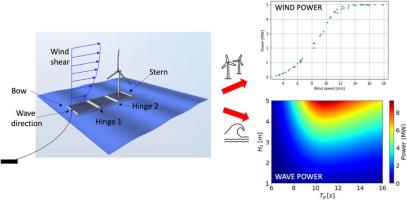最小电力基载混合式浮动风波能平台
IF 5.5
2区 工程技术
Q1 ENGINEERING, CIVIL
引用次数: 0
摘要
我们开发了一种新型的混合风波能源平台,用于需要最小功率基本负载以连续运行的应用。混合平台由三个非常大的浮筒组成,并用机械铰链连接。下游浮筒在甲板上携带一个5兆瓦的风力涡轮机。通过铰链运动提取波能。通过数值计算波浪能转换的功率矩阵,并假设风力机的平均发电量,对混合动力平台的性能进行了评估。不是根据功率变异性来评估性能,而是通过确定混合平台满足最小功率阈值的时间段来衡量性能,在没有风电的时间段。该平台在三个具有不同风浪相关特征的地点进行评估:一个在西班牙海岸外,一个在苏格兰西海岸,一个在苏格兰东海岸。结果表明,该平台在波浪功率密度高、风浪相关指数中低的位置具有较好的性能。混合概念除了具有模块化和可扩展性外,还可以满足最近部署在海上的稳态应用的要求。例如,氢电解槽,它需要一个最小的电源持续运行。本文章由计算机程序翻译,如有差异,请以英文原文为准。

A hybrid floating wind-wave energy platform for minimum power baseload
We develop a novel hybrid wind-wave energy platform for applications that require a minimum power baseload for continuous operation. The hybrid platform consists of three very large pontoons connected with mechanical hinges. The downstream pontoon carries a 5 MW wind turbine on deck. Wave energy is extracted trough hinge motion. By computing numerically a power matrix for wave energy conversion, and assuming mean power production for the wind turbine, we evaluate the performance of the hybrid platform. Rather than assessing performance in terms of power variability, performance is gauged by determining periods of time when the hybrid platform meets a minimum power threshold, in periods of time of absent wind power. The platform is assessed in three locations with different wind-wave correlation characteristics: One off the coast of Spain, one on the West and one on the East coast of Scotland. It is found that the platform has better performance in locations with high wave power density and low to intermediate wind-wave correlation indices. The hybrid concept, besides being modular and scalable, can meet the requirements of recently considered steady state applications to be deployed offshore. For example, hydrogen electrolysers, which require a minimum power supply for lasting operation.
求助全文
通过发布文献求助,成功后即可免费获取论文全文。
去求助
来源期刊

Ocean Engineering
工程技术-工程:大洋
CiteScore
7.30
自引率
34.00%
发文量
2379
审稿时长
8.1 months
期刊介绍:
Ocean Engineering provides a medium for the publication of original research and development work in the field of ocean engineering. Ocean Engineering seeks papers in the following topics.
 求助内容:
求助内容: 应助结果提醒方式:
应助结果提醒方式:


